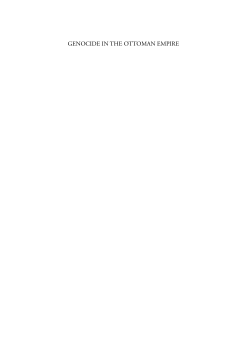
Additional Information
Book Details
Abstract
The final years of the Ottoman Empire were catastrophic ones for its non-Turkish, non-Muslim minorities. From 1913 to 1923, its rulers deported, killed, or otherwise persecuted staggering numbers of citizens in an attempt to preserve “Turkey for the Turks,” setting a modern precedent for how a regime can commit genocide in pursuit of political ends while largely escaping accountability. While this brutal history is most widely known in the case of the Armenian genocide, few appreciate the extent to which the Empire’s Assyrian and Greek subjects suffered and died under similar policies. This comprehensive volume is the first to broadly examine the genocides of the Armenians, Assyrians, and Greeks in comparative fashion, analyzing the similarities and differences among them and giving crucial context to present-day calls for recognition.
George N. Shirinian is Executive Director of the International Institute for Genocide and Human Rights Studies, a division of the Zoryan Institute. His publications include Studies in Comparative Genocide and The Asia Minor Catastrophe and the Ottoman Greek Genocide: Essays on Asia Minor, Pontos, and Eastern Thrace, 1913–1923.
“Overall this integrated genocide history is a valuable addition to the growing field of genocide studies, where cases start to mingle and enter the mainstream, stimulating us to ask larger questions in dense descriptions of regions as they erupt in violence, to paraphrase Charles Joyner.” • Genocide Studies International
“This comprehensive volume is the first to broadly examine the genocides of the Armenians, Assyrians, and Greeks in comparative fashion, analyzing the similarities and differences among them and giving crucial context to present-day calls for recognition. It is also one of the rare books which investigates the fate of the Ottoman Christian people during World War I as a whole, as not only Armenians, but Greeks and Assyrians were also targeted by the genocide carried out by the Young Turk's Ottoman Government. In the shadow of World War I, the Young Turk's aim was to exterminate the entire Christian population.” • Assyrian International News Agency News
Table of Contents
| Section Title | Page | Action | Price |
|---|---|---|---|
| GENOCIDE IN THE OTTOMAN EMPIRE | i | ||
| Contents | v | ||
| Illustrations | vi | ||
| Preface | viii | ||
| INTRODUCTION | x | ||
| PART I. CONTEXTS | 16 | ||
| CHAPTER ONE. THE BACKGROUND TO THE LATE OTTOMAN GENOCIDES | 18 | ||
| CHAPTER TWO. Convulsions at the End of Empire: Thrace, Asia Minor, and the Aegean | 82 | ||
| CHAPTER THREE. ASSYRIANS IN THE OTTOMAN EMPIRE AND THE OFFICIAL TURKISH POLICY OF THEIR EXTERMINATION,1890s–1918 | 104 | ||
| PART II. DOCUMENTATION AND EYEWITNESS ACCOUNTS | 132 | ||
| CHAPTER FOUR. Considering Genocide Testimony: Three Case Studies from the Armenian, Pontic, and Assyrian Genocides | 134 | ||
| CHAPTER FIVE: THE ASSYRIAN ISSUE 1914-35: Australian Documents and Press | 158 | ||
| CHAPTER SIX. ETHNIC CLEANSING, AMERICAN WOMEN, AND THE ADMIRAL: Deep in Anatolia during the Turkish Nationalist Revolution | 187 | ||
| CHAPTER SEVEN. FOUND IN TRANSLATION: Eyewitness Accounts of the Massacres in Nicomedia as Reported by Greek Journalist Kostas Faltaits | 214 | ||
| CHAPTER EIGHT. The Destruction of Smyrna in 1922: An Armenian and Greek Shared Tragedy | 227 | ||
| PART III. LEGACIES AND INTERPRETATIONS | 250 | ||
| CHAPTER NINE. Lemkin on Three Genocides: Comparing His Writings on the Armenian, Assyrian, and Greek Genocides | 252 | ||
| CHAPTER TEN. The Greek Genocide in the Ottoman Empire: Parallels with the Armenian Genocide | 274 | ||
| CHAPTER ELEVEN. THE GENOCIDE OF THE OTTOMAN GREEKS, 1913–23: Myths and Facts | 300 | ||
| CHAPTER TWELVE. “REDEEMING THE UNREDEEMED”: The Anglo-Hellenic League’s Campaign for the Greeks in Asia Minor | 322 | ||
| CHAPTER THIRTEEN. Genocide by Deportation into Poverty: Western Diplomats on Ottoman Christian Killings and Expulsions,1914–24 | 354 | ||
| CHAPTER FOURTEEN. THE SOCIO-PSYCHOLOGICAL DIMENSION OF THE ARMENIAN GENOCIDE | 402 | ||
| Index | 427 |
